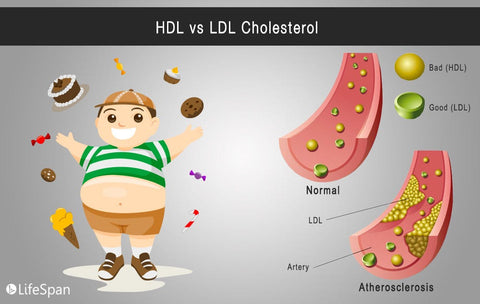Calculating Body Fat Percentage
To calculate your body fat percentage, measure the percentage of fat your body contains. Simply enough, if you weigh 150 pounds and have 10% body fat, it means that your body consists of 15 pounds of fat and 135 pounds of lean body mass such as bone, muscle, organ tissue, blood, and water.
A certain amount of healthy fat is essential for bodily functions. Fat regulates body temperature, cushions and insulates organs and tissues, and is the main form for energy storage in the body. Excess body fat, however, can lead to an increased risk of chronic disease such as high blood pressure, heart attack, stroke, cancer, and diabetes.

Body Mass Index (BMI)

Body mass index (BMI) is calculated using a person's weight and height. A person’s BMI is used as a screening tool to identify possible weight problems in adults. According to the BMI weight status categories, anyone with a BMI 25 or higher is overweight, and anyone with a BMI 30 or higher is obese.
It is important to understand that BMI is not a direct measure of body fat; BMI is calculated from an individual's weight, which includes both muscle and fat. As a result, some individuals may have a high BMI but not have a high percentage of body fat. For example, highly trained athletes may have a high BMI because of increased muscle on their body rather than having a high BMI because of excess body fat.
Although some people with a BMI in the overweight range (from 25.0 to 29.9) may not have excess body fat, most people with a BMI in the obese range (30 or higher) do have excess body fat and need to work to improve their overall body composition. If you have a high BMI and you have chronic disease risk factors such as high blood pressure or high cholesterol, you are at a much greater risk of developing a chronic disease than someone that has a normal BMI of 18.5 to 24.9.
Cholesterol
First, what is cholesterol? Cholesterol is a complex molecule found in all animals, including humans and is vital for a number of reasons. Cholesterol makes hormones and cell membranes, and carries out numerous cell functions. Our bodies cannot exist without cholesterol. However, too much cholesterol can lead to a build-up of plaque on our artery walls and lead to heart disease.

High-Density Lipoprotein (HDL)
High-density lipoprotein (HDL) is considered to be the “good” cholesterol in your blood. The HDL cholesterol acts like a garbage truck. As the HDL cholesterol travels through your bloodstream it picks up the “bad” cholesterol from the blood and artery walls and carries the low-density cholesterol (LDL), or bad cholesterol, to your liver for disposal.
Higher HDL levels are better. Low HDL cholesterol (less than 40 mg/dL for men; less than 50 mg/dL for women) puts you at higher risk for heart disease. In the average man, HDL cholesterol levels range from 40 to 50 mg/dL. In the average woman, they range from 50 to 60 mg/dL. An HDL cholesterol of 60 mg/dL or higher gives some protection against heart disease.
Smoking, being overweight and living a sedentary lifestyle can all result in lower HDL cholesterol. To raise your HDL level, avoid tobacco smoke, maintain a healthy weight, and get at least 30 to 60 minutes of physical activity most days of the week. Regular aerobic activity improves HDL cholesterol levels so make sure you exercise on a regular basis.
Low-Density Lipoprotein (LDL)
Low-density lipoprotein (LDL) is a lipoprotein in your blood and is known as the "bad" cholesterol. Low-density lipoproteins are considered bad because this is the cholesterol that sticks together and deposits itself inside the walls of your arteries. When cholesterol is deposited in the walls of the arteries, the arteries become stiff and narrow. If this happens in the coronary arteries, the arteries can become blocked. Blocked arteries lead to decreased blood flow and possibly a heart attack. If blockages occur in the cerebral arteries in the brain, the blockage will cause a stroke. Because LDL cholesterol is a major risk factor for heart disease, it is the main focus of cholesterol-lowering treatment. Your target LDL number can vary depending on your underlying risk of heart disease.
Most people should aim for an LDL level below 130 mg/dL. If you have other risk factors for heart disease, your target LDL may be below 100 mg/dL. If you are at very high risk of heart disease, you may need to aim for an LDL level below 70 mg/dL. It is good to have low LDL cholesterol levels, and there is no evidence to suggest that low LDL cholesterol levels are harmful.
When reviewing your LDL cholesterol level it is important to take into consideration your other blood lipid results and your risk factors for heart disease such as resting heart rate, blood pressure, and weight. If your other risk factors for heart disease are borderline high or already in the high or at-risk category, it is important to review your results with your physician. You can be successful lowering your LDL cholesterol by eating a healthier lower fat diet, not smoking, avoiding exposure to second-hand smoke, and exercising on a regular basis.
Triglyceride Levels
Triglycerides are a type of fat known as lipids and found in your blood. When you eat, your body converts any calories it doesn't need to use right away into triglycerides. This is why it is a sound practice to strive to only eat the calories that your body needs for energy based on your daily activity level.
For example, if you are going to be flying on an airplane for five hours across the country with limited time for movement and no time to fit in your usual 30 minute workout, consider eating lower calorie meals throughout the day. This will keep you from overeating more calories than you will burn in a day; keep your weight healthier; and, keep your triglyceride level in a healthy range.
If you do eat more calories than you are going to burn in a day to fuel your daily activities, the excess triglycerides will be stored in your fat cells. Later, hormones will release these stored triglycerides for energy when needed between meals. If you regularly eat more calories than you burn, particularly "easy" or “empty” calories like sugar, simple carbohydrates, and fats, you may have high triglycerides (hypertriglyceridemia).
Triglycerides and cholesterol are separate types of lipids that circulate in your blood. Triglycerides store unused calories and provide your body with energy, and cholesterol builds cells and certain hormones. Because triglycerides and cholesterol can't dissolve in blood, they circulate throughout your body with the help of proteins that transport the lipids (lipoproteins).
High triglycerides are often a sign of other conditions that increase the risk of heart disease and stroke, including obesity and metabolic syndrome — a cluster of conditions that includes too much fat around the waist, high blood pressure, high triglycerides, high blood sugar, and abnormal cholesterol levels.
Sometimes high triglycerides are a sign of poorly controlled type 2 diabetes, or low levels of thyroid hormones (hypothyroidism). High triglycerides can also be a side effect of taking medications such as beta blockers, birth control pills, diuretics, steroids, or the breast cancer drug tamoxifen.
Glucose
Your Blood Glucose results tell you how much glucose you have circulating in your blood. Glucose is a type of sugar in your blood that is fuel – it is very important, as your brain cannot function without it. Glucose is the main source of energy used by the body.
Insulin is a hormone in your body that helps your body’s cells to use or manage glucose. Glucose levels in the body must be managed to prevent “Hyperglycemia” or “High Blood Glucose.” The pancreas makes insulin and releases it into the blood based on how much glucose is circulating in the blood. As glucose levels in your blood increase, the pancreas releases insulin to manage the glucose to be sure the glucose level in the body doesn’t get too high.
Blood glucose levels that get too high and remain high over time can cause damage to the body, specifically the eyes, kidney, nerves and blood vessels. Diabetes occurs when the pancreas either produces little or no insulin, or the cells do not respond appropriately to the insulin produced by the pancreas resulting in ongoing high blood glucose levels. Blood glucose levels could also drop to a very low level in the body which is called “hypoglycemia.” Low Blood Glucose levels or “hypoglycemia” left uncontrolled is also very serious and damaging to the body.
Waist Circumference
Your waist circumference is an important health metric to know and to manage. You can easily monitor your waist circumference by simply measuring your waist on a regular basis. This single number can provide you with a wealth of information regarding your overall health and chronic disease risk, specifically your risk for heart disease, type 2 diabetes, stroke, high blood pressure, and some cancers. No matter what your height or weight, if your waist circumference is not in the “healthy/normal” zone you should focus on doing everything you can to improve it.
How to Measure Your Waist Circumference:
Use a flexible tape measure around your torso at your belly button. Pull the tape taut but not tight. Don’t make the mistake of measuring at the same place where the waist of your pants fit.









